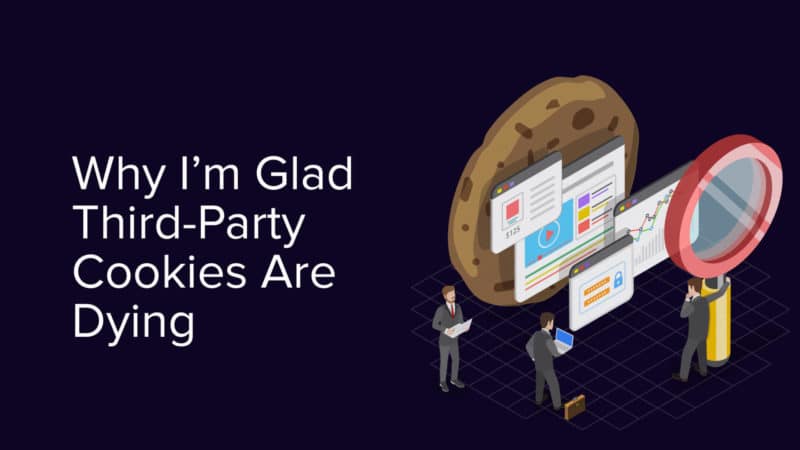
If you’re a data nerd like me, this year promises to be an exciting time — and a potentially dangerous one if you don’t have a game plan for adapting to the changes headed your way.
Ever since GDPR was rolled out in Europe back in 2016, the rules for how marketers can collect and use data have been getting stricter and stricter, but the real hammer blow will hit next year.
In 2023, Google says it will stop supporting third-party cookies in its Chrome browser, which represents about two-thirds of the global browser market. Google is following the lead of Apple and Mozilla, which already block those kinds of cookies in their Safari and Firefox browsers.
This represents a huge change because third-party cookies have been a go-to solution for measuring digital ad performance. For one thing, once Chrome goes dark, it will be almost impossible to see view-through conversions, i.e., if someone who viewed one of your ads didn’t click it but came to your website sometime later and converted.
(A lot of ad targeting options will probably disappear, too, though Google and others are trying to build replacements.)
Agencies and brands are freaking out because third-party cookies have been key to how they show their stakeholders that digital advertising isn’t a wasted effort.
Here’s the thing, though: Third-party cookies have never been a good way to demonstrate value – not value as most businesses define it, at least.
The problem with third-party cookies
Third-party cookies are predisposed to inflation and double-counting when it comes to conversions. And conversions, whether tied to an online purchase or a form submission, are what most businesses truly value.
Let’s say you’re using multiple channels in your latest campaign: Facebook, Google Ads and Trade Desk.
In the space of a day, John Doe is served ads from all those sources and then converts on your website. How many conversions were there? Just one. But each of those marketing channels is going to try and take credit for it, which they tracked using their third-party cookies. As a result, when you pull together reports for the entire campaign, what was one conversion is suddenly three.
Your money people are not dumb. They know how many purchases were made on the website (or how many leads were generated), so when Marketing rolls up and reports results that are three times larger than reality? They don’t trust you. They shouldn’t!
When we show up with a dashboard that says, hey, I generated 300 conversions, and there were only 100, our credibility is immediately lost.
And that’s why the death of third-party cookies is a good thing for marketing. It’s going to force us to accurately demonstrate how marketing investment creates leads, sales and revenue — the KPIs that actually reflect the overall health of the organization.
Why first-party tracking is a better choice
I’ll let you in on a little secret: You don’t need third-party cookies to tell that performance story. You just need first-party cookies on your website, like the kind that Google Analytics runs on.
With a first-party tracking strategy, you can still see which marketing channels and campaigns are bringing people to your website and leading them to convert. You can count how many visits or marketing touches it takes before they convert. You can also give credit to channels like organic search and email that third-party cookies from your media platforms wouldn’t be able to track.
And double-counting isn’t a problem anymore because, instead of 20 different ad platforms claiming credit for one conversion, Google Analytics becomes your sole source of truth for conversions.
This is all based on clicks through to your website, but your marketing reports can still incorporate cost and impression data from your top-of-funnel paid media.
You can see this in the Lead Pipeline Dashboard below. Read it from left to right, and you can understand how marketing investment (cost) translates to impressions. That data is pulled directly from Facebook, Google Ads, or whatever ad platform is being used.

You can also see how impressions correlate to leads without the risk of double-counting because the lead count is being pulled from Google Analytics.
And if you bring in lead data from your CRM, you can continue following the impact through the qualified lead, opportunity and customer stages of your funnel.
In one place, you’re telling an end-to-end story that shows exactly how marketing creates value in terms that stakeholders understand and appreciate. Finally, marketing gets the credit and respect that it deserves as a driver of business.
This is an opportunity
That’s why, ultimately, I’m excited about the end of third-party cookies, and you should be, too. You can still get the data you need to measure, optimize and even predict marketing ROI without them.
If you need help navigating these changes, let’s talk – our team can help. But don’t wait for the last gasp of third-party cookies. Take action now.
The post Why I’m glad third-party cookies are dying appeared first on Search Engine Land.
source https://searchengineland.com/why-im-glad-third-party-cookies-are-dying-382257

0 Comments